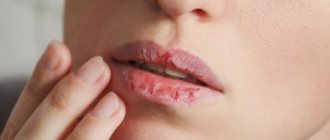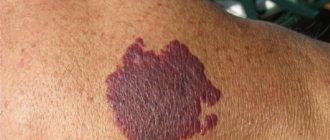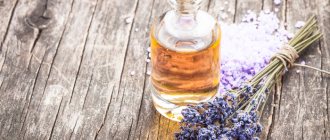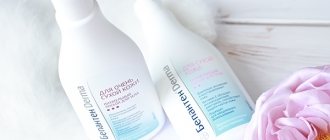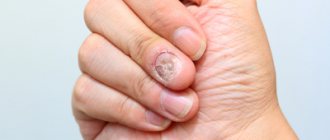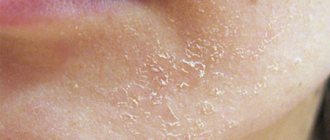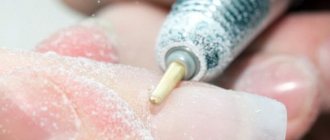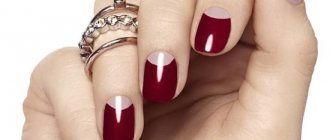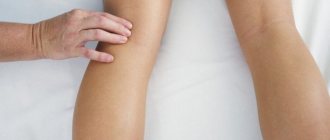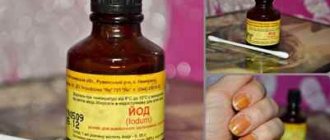Doctors say that the state of a person’s health can be determined by the condition of the nails. Fragile, brittle, dry nails indicate a lack of vitamins and minerals in the body. The structure of the plate consists of keratin and a water-fat layer. Lack of moisture is manifested by stripes on the nail plate, spots, discoloration and loss of brightness and shine of the nail. Dehydration affects both the cuticle and the skin around the fingers. The main cause of nail problems is considered to be a deficiency of vitamins and minerals. But external influences also play an important role on the condition of the nail plate.
Causes
The main factors leading to dry nails are:
- Aggressive dishwashing and apartment cleaning products containing acids and alkalis spoil the top layer of the nail and dry out the skin around it.
- Working with soil.
- Mechanical pedicure, grinding and treatment with harsh abrasives cause microtrauma to the nail and cuticle.
- Varnish, acrylic coatings and nail polish removers containing acetone-containing elements dry the top layer of the nail.
- Metabolic disorders and disruption of the endocrine system have a negative impact on the condition of the nail plate.
- Nail fungus and skin diseases cause damage to the nail by viruses and microbes.
If the problem is caused by external irritants, then solving it will not be difficult in most cases. It is enough to eliminate exposure to an aggressive environment and carry out the necessary restoration procedures.
Causes of dry nails
Our nail consists of translucent keratinized plates that protect the sensitive tissue located at the tip of the finger from damage. A sign of healthy nails is natural shine, smoothness, absence of white spots and split ends. If the nail is still not healthy, we will consider the main possible causes of this problem.
Household chemicals.
Often, while cleaning and washing dishes, we don’t think about protecting our hands. After all, cleanliness in the house requires the use of aggressive detergents. By washing plates from grease, the stove from carbon deposits, and disinfecting the bathroom, we simultaneously wash away calcium and fat from our nails and the skin of our hands. Make it a rule not to come into contact with detergents and cleaning products unless your hands are protected with gloves. If you need to work in rubber gloves for a long time, then smear your hands with rich cream, put on gloves made of natural fabric and only then rubber ones.
Manicure.
“Beauty requires sacrifice,” we tell ourselves and once again apply nail polish, good, if not cheap. And then we remove it with a nail polish remover containing acetone, which penetrates deep into the porous structure of the nail, dries out and destroys it. As a result, the nail peels off and does not grow, and resourceful women go to get their nails extended. This aggravates the problem even more, since the nail plate is significantly damaged during extensions. It's not worth saving on either. Low-quality tools will not give the expected result; they can even damage the skin on the fingers and the nail itself.
Nutrition.
Everyone knows that nutrition should be balanced. But there is not always the opportunity and desire to make it this way. Especially if a woman is on a diet or prefers sweets over healthy ones. As a result, the body will not receive enough necessary vitamins, microelements, and healthy fats. The consequences are immediately visible on the skin and nails.
Diseases of the endocrine system.
Dry nails can also be caused by more serious reasons. It may be the result of a malfunction of the thyroid gland. Before starting treatment, be sure to consult a doctor for advice.
Treatment
A dry nail plate is dangerous because the cracks that appear on it deepen over time and serve as a real gateway for fungal infections and bacteria. Once the condition of the hands is neglected, the skin and nails will imperceptibly reach a bleeding, painful state.
With 99% confidence, we can say that you will need a course of taking vitamin-mineral complexes with a high content of vitamins A, E, D. If the problem was caught at the beginning, then perhaps you can saturate the body with vitamins using food. Vegetables and fruits, fish and beef liver, bread with bran and cereal sprouts should be added to the diet.
The use of cosmetic moisturizers and home remedies from available substances helps to cope with dryness of the nails and the skin around them.
Folk
Baths, masks and hand care creams can be bought in pharmacies, beauty salons or made from improvised products.
Baths
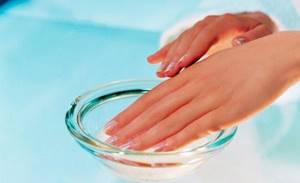
If your nails become thin and begin to peel, a bath of regular table salt will help. You need to add a little salt to warm water and hold your hands for about 15 minutes. Salt kills infections and promotes the accumulation of moisture. Baths made from medicinal plants and essential oils are good for disinfecting nail plates and moisturizing the skin:
- Chamomile decoction;
- Oak bark decoction;
- Tea tree oil;
- Decoction of potatoes with the addition of a few drops of vegetable oil.
The temperature of the healing liquid should be comfortable for the hands. After the procedure, wash your hands with warm water and lubricate with nourishing cream.
Masks
Often, after cooking, pieces of boiled and fresh vegetables and fruits remain. This waste can be successfully used to nourish the nails and skin of the hands. Just mash a piece of vegetable, add vegetable oil and apply to your hands. Keep the mask for 10-15 minutes and rinse with warm water.
Blue clay is considered an excellent product for cosmetic masks. They can be used no more than once a week. Dilute a spoonful of clay powder with warm water and add a few drops of olive oil. If there are microcracks, it is recommended to add a couple of drops of pharmaceutical iodine or tea tree oil. This will help further protect the nail from fungal infection. You can keep the mask on your hands for no more than 30 minutes. After this, rinse with warm water and apply nourishing cream to your hands.
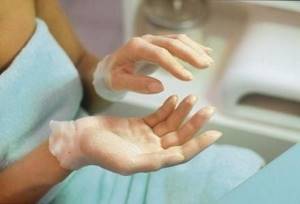
Wax masks at night do an excellent job of exfoliating the nail plates and nourishing the skin around them. They can also be used to treat dry toenails. Heat the beeswax in a water bath, add half a teaspoon of honey or a little salt. Dip your fingers into the melted wax for a few seconds and let cool. Wear soft gloves (wear socks when treating feet). Apply the mask throughout the night no more than once every three days. In the morning, just wash off the mask with very warm water.
Hand care is quite simple and does not take much time. Alternating treatments will help prevent dryness problems.
Dry toenails causes
Doctors say that the state of a person’s health can be determined by the condition of the nails. Fragile, brittle, dry nails indicate a lack of vitamins and minerals in the body. The structure of the plate consists of keratin and a water-fat layer.
Lack of moisture is manifested by stripes on the nail plate, spots, discoloration and loss of brightness and shine of the nail. Dehydration affects both the cuticle and the skin around the fingers. The main cause of nail problems is considered to be a deficiency of vitamins and minerals.
But external influences also play an important role on the condition of the nail plate.
Causes
The main factors leading to dry nails are:
- Aggressive dishwashing and apartment cleaning products containing acids and alkalis spoil the top layer of the nail and dry out the skin around it.
- Working with soil.
- Mechanical pedicure, grinding and treatment with harsh abrasives cause microtrauma to the nail and cuticle.
- Varnish, acrylic coatings and nail polish removers containing acetone-containing elements dry the top layer of the nail.
- Metabolic disorders and disruption of the endocrine system have a negative impact on the condition of the nail plate.
- Nail fungus and skin diseases cause damage to the nail by viruses and microbes.
If the problem is caused by external irritants, then solving it will not be difficult in most cases. It is enough to eliminate exposure to an aggressive environment and carry out the necessary restoration procedures.
Treatment
A dry nail plate is dangerous because the cracks that appear on it deepen over time and serve as a real gateway for fungal infections and bacteria. Once the condition of the hands is neglected, the skin and nails will imperceptibly reach a bleeding, painful state.
With 99% confidence, we can say that you will need a course of taking vitamin-mineral complexes with a high content of vitamins A, E, D. If the problem was caught at the beginning, then perhaps you can saturate the body with vitamins using food. Vegetables and fruits, fish and beef liver, bread with bran and cereal sprouts should be added to the diet.
The use of cosmetic moisturizers and home remedies from available substances helps to cope with dryness of the nails and the skin around them.
Folk
Baths, masks and hand care creams can be bought in pharmacies, beauty salons or made from improvised products.
Baths
If your nails become thin and begin to peel, a bath of regular table salt will help. You need to add a little salt to warm water and hold your hands for about 15 minutes. Salt kills infections and promotes the accumulation of moisture. Baths made from medicinal plants and essential oils are good for disinfecting nail plates and moisturizing the skin:
- Chamomile decoction;
- Oak bark decoction;
- Tea tree oil;
- Decoction of potatoes with the addition of a few drops of vegetable oil.
The temperature of the healing liquid should be comfortable for the hands. After the procedure, wash your hands with warm water and lubricate with nourishing cream.
Prevention
You can avoid problems with brittle nails and cuticles by following some simple rules.
- When using aggressive products with acids to care for dishes and household items, be sure to wear rubber gloves.
- When working with soil in the country, in the garden or when caring for indoor flowers, you must use gloves and immediately lubricate them with nutrients after washing your hands.
- For manicure (pedicure), use clean hygiene equipment.
- Don’t forget to treat your hands with antiseptics after a manicure to avoid the risk of fungal infections.
- Use high quality nail polishes and acrylics.
Hands are considered a mirror reflecting the state of human health. Therefore, if your nails begin to peel or break, you should consult a doctor to eliminate the risk of developing diseases.
Why the skin under the nails peels, cracks, methods of care and treatment
Household chemicals, used everywhere for daily cleaning and washing, dry out the upper layers of the epidermis. After each contact, the fingers feel tight, and over time, without systematic care, they become cracked and rough.
The most natural reason for the appearance of cracks and peeling under the nails is constant manual work. Even gloves provide only temporary protection of the skin from damage.
Main reasons
The skin on the hands, and especially under the nails, is most often exposed to various factors. Cracks appear due to the following reasons:
- Mechanical work.
- Fungal infection.
- Contact with household cleaning products.
With mycosis, the first symptoms are changes in the epidermis in the form of dryness and roughness.
These signs are easily eliminated with cosmetics that intensively nourish the tissue. Over time, in the absence of antifungal treatment, the infection spreads to the nails, and they begin to peel off from their bed, peel and break.
Reduced immunity and a humid, warm environment are favorable conditions for fungi to colonize the area under the nails.
Treatment of skin cracks under fingernails
If problems arise with peeling in the periungual space, treatment should include:
- Taking vitamins.
- Ointment, glue and cream.
- Paraffin therapy.
- Masks with glycerin or mummy.
- Antifungal drugs.
To restore weakened immunity, medication is necessary. It is best to drink medications that contain a large amount of vitamins and microelements. Among them, Alphabet and Complivit are considered the best.
Boroplus and Panthenol creams effectively cope with peeling and cracks. They accelerate tissue healing and also soften them thanks to the content of nutrients specifically balanced to restore skin that is prone to dryness.
If cracks appear under the fingernails and the nourishing agents do not cope with the task, then medical glue will come to the rescue. A drop of the drug is applied to the damaged area, which hardens almost instantly. The glue facilitates the healing of cracks and serves as a kind of protection against infection entering the wound.
Paraffin therapy has a good therapeutic effect. It can be done at home if you have a special bath for melting paraffin. If not, then a water bath will do. Paraffin therapy lasts no more than 15 minutes, and then, to consolidate the effect, cosmetic gloves are put on for 20-30 minutes.
Before the procedure, the fingers are lubricated with a rich cream. This helps protect them from burns.
A glycerin-based mask not only has moisturizing properties, but also protects the skin well. To prepare it you will need a tablespoon of baking soda. It is mixed with glycerin, and a little flour is added to give the mixture thickness.
When the mask is ready, it is applied to the damaged areas under and around the nails. The duration of the procedure should not exceed 15 minutes. It is recommended to perform it in the evening so that after removing the mask there is no contact with water.
When peeling appears, the following care methods will help cope with the problem. If cracks join, then pain occurs and it is impossible to touch them. Shilajit will help you cope with damage and discomfort.
Several tablets are dissolved in water and applied to painful areas. It is necessary to keep this remedy for as long as possible. Shilajit not only fights pain, but also accelerates tissue healing.
When the cause of problems with the epidermis is a fungal infection, then in addition to cosmetics, drugs are also needed to destroy mycosis.
Effective are:
- Clotrimazole.
- Batrafen.
- Candide.
- Loceril.
- Exoderil.
They are produced in the form of solutions, tablets or varnishes. If the nail is affected, then medicinal products are applied to its surface. The duration of treatment and frequency of application per day is determined by the dermatologist, depending on the severity of the disease.
Prevention of peeling skin under nails
To avoid dryness and cracks, regular use of nourishing and moisturizing products is necessary.
Additionally, it is recommended to carry out skin care procedures using homemade cosmetics. In the autumn and spring periods, prophylactic intake of a complex of vitamins is recommended. All these activities will help maintain the elasticity, softness of the skin and its healthy color.
Source: //kseroz.ru/telo/suhost-i-treshhiny-kozhi-pod-nogtyami.html
Diagnosis of dry nails and finger skin
It is important to carefully examine the nail plate to identify the following signs:
- the nail has no shine, is cloudy;
- there are vertical stripes on the nails;
- whitish spots all over the nail;
- lack of smoothness of the nail plate.
These symptoms indicate that the nails lack natural moisture. Nails consist of three layers, the first of which are soft and hard keratin. Between them there is a water-fat composition. If any component is missing, delamination occurs. This problem is more serious. Healing the nail plate becomes more complicated than simply increasing the moisture content between the layers of the nail.
Often, lack of moisture in the body affects the skin around the nails. Redness and peeling appear on it. Sometimes there is severe pain from cracks and wounds. This means that the skin loses its elasticity due to dehydration. The cuticle is also susceptible to moisture loss, resulting in painful hangnails appearing on the fingers. It is wrong to think that only the hands suffer from such troubles. Manifestations of moisture deficiency are also possible on the feet, resulting in the appearance of cracks, wounds, and brittleness of the nail plate. In the case of toenails, the reasons may be more serious.
Folk remedies for dry nails
And nail problems can often be solved at home without turning to specialists. The main thing is to provide regular nutrition with special oils. Also, do not forget to lubricate the skin at the base of the nail with cuticle cream.
Wax for nail growth
Grind the beeswax and heat it in a steam bath. Add the heated wax to the warm wax and mix. You need to take half as much oil as wax. Add five drops and three drops of vitamin E to the mixture, which helps strengthen the nail. Pour the mixture into a small container, let cool and harden. Apply a small amount of the prepared mixture to the nails and rub in thoroughly. No need to rinse off.
Argan-lemon mask
essential oils of peppermint, lavender, geranium and tea tree.
Dissolve this aromatic cocktail with salt in warm water. Keep your nails on for 10 minutes. If you often extend your nails or paint them with gel polish, then unrefined olive oil will help you restore the damaged plate, apply a small amount of it to small cotton pads and place on each nail. Tear off small strips from the foil and wrap the cotton wool around the nail. After twenty minutes we shoot and enjoy the result.
Every day, hands are exposed to external influences and temperature changes. There are several reasons for the thinning of the skin around the nails; this process can also be associated with disruptions in the functioning of the entire body. Creams, ointments and even tablets will help eliminate the problem. This will be discussed in more detail below.
Source of dehydration of nails and skin around them
Before you start using various remedies, you need to determine why the problem occurred. The main causes of nail problems:
- use of chemicals in everyday life (washing dishes, hand washing);
- frequent use of an acetone-containing solution to remove nail polish;
- daily excess moisture when solving household tasks (dishes, wet cleaning);
- applying low-quality nail polish;
- use of an inappropriate file, incorrect filing procedure;
- deficiency of microelements necessary for the body;
- diseases of the endocrine system.
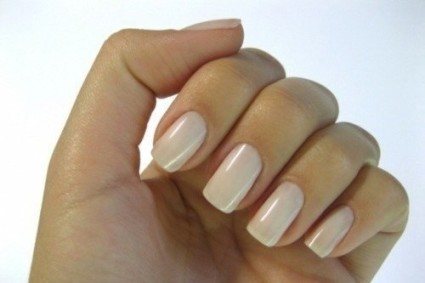
If the skin around the fingers and cuticles are also problematic, the following reasons are possible:
- improper care of hands and cuticles;
- using soap with alkaline or antibacterial substances;
- non-compliance with the principles of healthy eating;
- presence of fungal infection.
Brittle nails, cuticles with hangnails, or dry skin on the toes may indicate dangerous diseases such as fungus, psoriasis, eczema, reactions to medications, and the development of diabetes.
It is important not to neglect the problem and consult a doctor. If they rule out problems with internal organs, the problem can be solved without their intervention.
Reasons for the problem
There can be several reasons for the appearance of dry skin around the fingernails:
- weakened immune system;
- poor nutrition;
- influence of chemicals.
Secondary factors will help identify the cause of this symptom. If inflammation, redness, and itching also appear on the skin of the hands, then the person most likely has a fungal infection. It may even be accompanied by blackening of the area around the nails. In this case, you should not self-medicate; you should immediately consult a doctor.
Nutrition as a factor in dry skin
Amino acids are responsible for the growth of epidermal cells in the human body; their lack leads to dry skin.
You can reduce the amount of amino acids you receive through diet. A change in diet affects the functioning of the immune system, which will provoke a peculiar reaction in the form of peeling of the skin of the hands around the nails. The lack of vitamins B, A and E, which are responsible for the elasticity and beauty of the skin, also affects its appearance. Improper nutrition deprives the body of essential microelements and minerals, which provokes metabolic disorders in the body. Therefore, a person needs to eat proteins every day; they are the building blocks of the body that create the skin. Lack of proteins causes dryness of the epidermis. Fats are responsible for the elasticity of the epidermis; they also need to be included in the diet in the right quantity in accordance with the individual characteristics of the body.
How household chemicals affect the skin
If the skin around your fingernails is dry, the cause may be the aggressive effects of household chemicals. Washing dishes or cleaning an apartment without protective gloves exposes the skin of your hands to negative effects. It gets rough, so you need to wear rubber gloves when doing housework.
Other reasons
The skin of the hands around the nails dries and cracks due to the negative influence of weather factors. Sudden changes in temperature, exposure to direct sunlight, and low air humidity provoke peeling of the epidermis. Cold and dry air dry out the skin. Frequent hand washing has the same consequences, since the alkaline environment of soap constantly washes away the protective layer of the skin.
Hand creams can not only save the healthy appearance of your hands, but also harm them. Individual incompatibility of components can cause peeling and further development of the problem.
Many people are concerned about dry skin around their fingernails. The causes may also have their roots in the following chronic diseases:
- hormonal disbalance;
- diabetes;
- metabolic failure;
- disruption of the gastrointestinal tract.
Presence of dry and brittle nails in children
This problem occurs not only in adults. She also often lies in wait for children. A torn cuticle is very painful for a child. The reason for this is considered to be the tenderness of children's skin. Often the precursor to dryness, brittleness of the nail plate, and cracks on a child’s fingers is a fungus that must be treated immediately. The digestive organs should be checked.
A deficiency of zinc, magnesium, calcium, and phosphorus can also affect a child’s nails.
If no obvious diseases are detected, you can reconsider the child’s diet. The baby's diet needs oils, nuts, eggs, dried fruits, fish, buckwheat, and oatmeal. Vitamin deficiency is overcome with the help of specialized vitamin preparations.
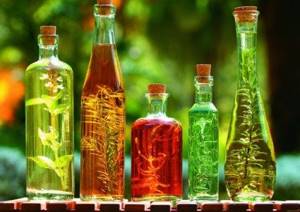
Important: Approach the problem comprehensively. Use any vegetable oil (1-2 drops) for daily rubbing and nail bath (2-3 times a week).
To prepare the bath you will need lemon juice (1 tsp), iodine (2 drops), glycerin (100 g). These ingredients should be warmed up a little, and the child’s fingers should be immersed in them for 10 minutes. After the procedure, wash your hands in warm water and wipe with a towel. This action greatly strengthens the child’s brittle nails. It is very important to maintain regularity of procedures.
How to avoid dry skin
If the skin near the nails constantly dries, then it is necessary to take measures to prevent the negative effects of external factors. To do this you need:
- Dry your hands thoroughly after washing.
- Reduce the time your hands spend in the aquatic environment.
- Use mild soap with low alkali content.
- In winter, wear mittens and gloves made of natural material.
- Monitor the balance of vitamins and minerals in the body, and if there is a shortage, try to make up for this deficiency.
- When working with household chemicals, use rubber gloves.
- Moisturize and nourish the skin 2-3 times a day with cream.
Dry hand skin near the nails has many causes, so there is no universal advice for getting rid of the problem. It is necessary to carefully monitor the functioning of the entire body. For prevention purposes, it is necessary to drink vitamin complexes once a season, eat fruits and vegetables, as well as fish rich in fats. Nourish your hand skin daily with high-quality natural creams and moisturize it at least once a week.
Dry nails bother many people, especially in winter and spring. Dry nail plate is often accompanied by problems with the cuticle and skin around the fingers. Sometimes this phenomenon is observed on the legs. Adults and children are susceptible to dry nails. What should you do if your child develops cracks in the skin around the nails and painful hangnails due to dryness? It is necessary to find out the causes and ways to solve this problem.
Self-treatment for dry hands and nails
Dry fingernails require special attention. To heal in natural, home conditions, you can use various products to care for your nails and the skin around them. The nail plate needs vitamins A and E. You can buy them at the pharmacy, add them to any vegetable oil, and then rub them into the nails and the skin around them. Baths and natural masks at home are inexpensive, but the effectiveness of their use is not inferior to expensive salon procedures.
Baths for treating dry hands and feet
Boiled potato bath. Stir 1 cooked crushed potato tuber, 2 cups of water and 1 cup of milk. If desired, you can add olive or burdock oil (1 tsp). Place your hands in the mixture for 20 minutes.
After such a bath, your hands should be rinsed with warm water, wiped with a soft cloth, and lubricated with liquid cream.
The skin on your fingers and palms will stop peeling if you use starch baths. Add 1 tbsp to a liter of water (45–50 degrees). l. potato starch. Soak your hands in the solution for 15 minutes, then wipe them with a soft cloth and lubricate them with a rich (nourishing) cream.
Vitamin bath. For the bath, dilute lemon juice (2 tbsp) and the same amount of sea salt in a glass of water (45–50 degrees), add grape seed oil (2–3 drops). Warm your fingers in this liquid for 15 minutes. After completing the procedure, you should dry your fingers with a towel and apply any nourishing cream. Such baths are recommended to be carried out once a week.
How to fix the problem
Masks
Creams and ointments from the pharmacy that include vitamin E will help you cope with peeling skin near your fingers. The most effective remedies include Radevit, Bepanten, D-Panthenol
.
Actovegin
will help cope with deep cracks ; it deeply moisturizes and nourishes the area around the fingernails.
A more budget-friendly mask can be made yourself at home from two tablespoons of glycerin and one spoon of honey. To thicken the mass, add a teaspoon of flour, then apply to the area around the nails and wait 20 minutes, then rinse.
Vegetable oils sold in the same pharmacy will help restore the skin and moisturize the cuticle, as they are saturated with vitamins A, E and other components important for the epidermis. As oils you can take almond oil, wheat germ oil, shea butter and argan oil. To get more effect, you need to mix them in equal proportions and apply to problem areas for half an hour, then blot off the remaining oil with a dry cloth.
A currently fashionable salon procedure using cosmetic wax will quickly cope with dry skin. To carry it out at home, you need to dip your fingers in cosmetic wax melted in a water bath, wait for it to harden, then put on gloves made of natural material and go to bed, and carefully get rid of the wax in the morning.
Baths
- Starchy. Dilute one teaspoon of starch in 0.5 liters of high temperature water, hold your hands in the mixture for 20-30 minutes, dry your hands and apply moisturizer.
- An aqueous solution of mummy tablets will help relieve itching and burning. The resin included in their composition has incredible healing properties. You need to keep your hands in the bath for about 15 minutes.
Non-pathological causes
Why do my toenails crumble? One of the most common reasons is wearing tight, closed and uncomfortable shoes. In it, the nails are constantly exposed to mechanical stress, so the regeneration process accelerates, there are too many new cells, the nail plate extends beyond the bed, and upward growth begins. Then the thickening and yellow tint are clearly noticeable. In some cases, longitudinal lines and cracks appear.
Many girls, after removing gel polish or false nails, cannot boast of the beauty of their nails. As a rule, everything depends on the professionalism of the master; such mistakes are often made by novice specialists. Girls are not recommended to skimp on varnish. In the case of nails, quality should come first.
Lack of iron in the body often causes toenails to crumble and peel. This is especially true for the big toe, both on the feet and on the hands. The same symptoms can be observed if a person has a weakened immune system; as a rule, with the deterioration of nails, there is a deterioration in the condition of the hair and skin. Lack of sulfur, vitamin C, and B vitamins also negatively affects the condition of nails.
Some medications can cause negative effects on the nail plates. Do not forget that heredity plays an important role.
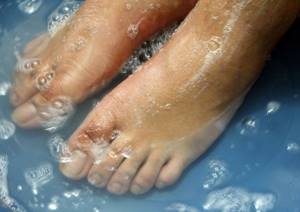
The toenail is crumbling: causes, treatment and photos
It's no secret that the first impression is very important, and even nails, or rather their condition, influence the overall positive opinion. But there are many factors that affect the condition of nails; they can peel, crumble or change color.
Good condition of nails is also an indicator of the excellent functioning of internal organs. Even if there is no dangerous pathological process in the body yet, the condition of the nails can still indicate what elements are missing in the body.
Non-pathological causes
Why do my toenails crumble? One of the most common reasons is wearing tight, closed and uncomfortable shoes.
In it, the nails are constantly exposed to mechanical stress, so the regeneration process accelerates, there are too many new cells, the nail plate extends beyond the bed, and upward growth begins.
Then the thickening and yellow tint are clearly noticeable. In some cases, longitudinal lines and cracks appear.
Lack of iron in the body often causes toenails to crumble and peel. This is especially true for the big toe, both on the feet and on the hands.
The same symptoms can be observed if a person has a weakened immune system; as a rule, with the deterioration of nails, there is a deterioration in the condition of the hair and skin.
Lack of sulfur, vitamin C, and B vitamins also negatively affects the condition of nails.
Some medications can cause negative effects on the nail plates. Do not forget that heredity plays an important role.
Pathological causes
If your toenails are crumbling, the cause may be an organic disease. Problems can arise due to untimely treatment of the disease if it is protracted and chronic. Along with the deterioration of the nails, a rash appears on the skin, the hair becomes sparse and dry.
Diabetes
Many people know that diabetes mellitus disrupts the functioning of the entire body, and other pathologies develop against the background of the disease. Toenails are no exception: they turn yellow and crumble - this is a sign of diabetic onychomycosis.
This is due to the fact that with this disease the concentration of sugar in the blood increases, which leads to damage to blood vessels and nerve endings. On the legs, such problems occur very quickly, because they are as far away from the central nervous system as possible. In addition, the lower limbs are under constant stress, and wounds and cracks there heal much more slowly.
People diagnosed with diabetes mellitus have another problem - the nail often grows into the surrounding tissue, and this is a huge risk of infection or the appearance of trophic ulcers.
However, most antifungal agents have a negative effect on insulin metabolism, therefore, their use requires constant monitoring by medical professionals.
This, of course, is a medical name; psoriasis on the fingernails and toenails is popularly called this. As a rule, such a disease does not occur separately from skin psoriasis. In addition to the fact that the toenail crumbles, it is destroyed from the inside.
At a certain period of time, papules may appear on the nails, which slightly resemble yellowish puddles. These papules contain pus, which is released as the nail grows. Another symptom is itching; it is impossible to immediately determine where exactly it is; it seems that it is on the fingers or under the nails.
The danger of the disease is that you can completely lose the nail plate, and before that the person will be tormented by discomfort.
And the worst thing is that psoriatic onychodystrophy is incurable; all therapy is aimed only at eliminating symptoms and discomfort. But under no circumstances should you refuse treatment; it will help reduce the risk of relapse.
Eczema
Is your toenail crumbling? Perhaps it's eczema. Yes, this chronic disease can manifest itself not only on the skin, but also on the nails. However, eczema first appears on the skin, then spreads to the nails.
At first, the hole on the nail plate becomes cloudy, begins to peel off, becomes loose and flakes. The nail itself becomes covered with transverse grooves, depressions appear, it crumbles and breaks. Swelling around the nail appears, blisters form, the skin cracks and peels. In advanced cases, the nail plate may completely separate from the nail bed.
This type of disease can be treated locally. Ointments containing vitamins are prescribed. You will have to follow a diet and carefully monitor hygiene. In this situation, nail extensions can help. The procedure will not only hide the problem, but also straighten the nail plate. Naturally, extensions can be carried out only after a course of treatment.
Other pathological problems
In addition to the reasons described above, a toenail may crumble in other cases:
- Climax. During this period of life, when hormonal changes occur in the female body, there is a serious lack of estrogen. And this is a violation of mineral metabolism, almost all organs suffer.
- Liver diseases. In such cases, the metabolism in the body is disrupted, which is why the nails suffer.
- Lichen. This is a viral disease that requires medical intervention.
- Intoxication of the whole body.
But still, the most common reason for a toenail crumbling is fungal diseases. Onychomycosis can be contracted in the most unexpected places: on the beach or in the pool. Doctors are also confident that people with a genetic predisposition are more often susceptible to this disease, that is, if the fungus is present in blood relatives, then the child has a huge risk of also getting onychomycosis.
How to treat?
If the nail on your big toe is crumbling, but it is clearly known that this is not due to any disease, then, first of all, you should start with adjusting your diet. The menu should include the maximum amount of fruits (apricots, citrus fruits), fermented milk products, spinach and nuts.
To achieve the maximum required level of iron, selenium and iodine in the body, it is not necessary to take pills. There is a lot of it in apples, seafood, beef liver, seaweed, and brewer's yeast.
You can take baths with sea salt every day. It is recommended to treat the damaged finger daily with sea buckthorn or olive oil.
Salon treatments
What to do - your toenails are crumbling... Sign up for treatments. However, before going to a beauty salon, it is still recommended to undergo an examination to exclude any pathology.
One of the most popular procedures is paraffin therapy. It is somewhat reminiscent of a wax procedure that can be done at home. The salon may offer you a massage course; by the way, many effective techniques have been invented for nails.
Some salons offer a course of diathermy, that is, exposure to nails in order to improve vascular nutrition and blood circulation. Similar to the hospital procedure - ultraphoresis, salon procedures are also carried out, only with the name vitamin ultraphoresis. When treating nails, their surface is saturated with vitamin compounds.
The sealing procedure involves applying a nutrient solution to the nail and securing it with wax. The effectiveness of the procedure can be observed for three months, then you will have to repeat everything again. What else can you do if your toenail crumbles?
Spa pedicure is not a one-day procedure, but a whole complex that involves not only a visit to the salon, but also care at home.
Prevention
If your toenails are crumbling, treatment is, of course, required, but it is best to prevent this condition. First of all, you should control sweating on your feet and hands. Be sure to wash your feet daily, even if they seem clean.
After visiting public places, especially those with high humidity (swimming pool, sauna, beach), it is better to treat the limbs with a special antifungal aerosol.
Women should not skimp on cosmetics, including nail polishes. Don't forget to apply a protectant before applying varnish. If you prefer salon procedures, then carefully choose a specialist so that he is responsible for the sanitary treatment of instruments.
And, of course, eat a balanced diet, avoid spontaneous snacks and fast foods, as such nutrition causes vitamin deficiency in the body.
Source: https://FB.ru/article/403874/kroshitsya-nogot-na-noge-prichinyi-lechenie-i-foto
Diabetes
Many people know that diabetes mellitus disrupts the functioning of the entire body, and other pathologies develop against the background of the disease. Toenails are no exception: they turn yellow and crumble - this is a sign of diabetic onychomycosis.
This is due to the fact that with this disease the concentration of sugar in the blood increases, which leads to damage to blood vessels and nerve endings. On the legs, such problems occur very quickly, because they are as far away from the central nervous system as possible. In addition, the lower limbs are under constant stress, and wounds and cracks there heal much more slowly.
People diagnosed with diabetes mellitus have another problem - the nail often grows into the surrounding tissue, and this is a huge risk of infection or the appearance of trophic ulcers. Accordingly, with this disease it is necessary to pay special attention to the feet and nails and treat them with special means. However, most antifungal agents have a negative effect on insulin metabolism, therefore, their use requires constant monitoring by medical professionals.
More rare causes
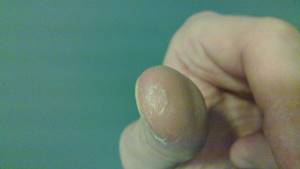
Much less often, the skin around the nails dries out, peeling and cracking occurs due to an unfavorable environment. Sudden temperature changes from hot to cold, excessive exposure to sunlight, ultraviolet radiation, and excessive dry air cause cracking of the epidermis. In this case, the peeling is much less intense and causes less inconvenience.
This happens as a result of the skin drying out very quickly. Moreover, cold in this sense is more dangerous than dry air. However, keeping your hands in hard water causes the same effect. Frequent hand washing, especially with soap, promotes more intense peeling.
The use of unsuitable cosmetics is also a reason why the skin may become dry. However, this happens much less frequently. It is important to choose hand and nail creams that are suitable for your skin type.
[yandex2] [google2]
Psoriatic onychodystrophy
This, of course, is a medical name; psoriasis on the fingernails and toenails is popularly called this. As a rule, such a disease does not occur separately from skin psoriasis. In addition to the fact that the toenail crumbles, it is destroyed from the inside. At a certain period of time, papules may appear on the nails, which slightly resemble yellowish puddles. These papules contain pus, which is released as the nail grows. Another symptom is itching; it is impossible to immediately determine where exactly it is; it seems that it is on the fingers or under the nails. The main danger of the disease is that you can completely lose the nail plate, and before that the person will be tormented by discomfort.
And the worst thing is that psoriatic onychodystrophy is incurable; all therapy is aimed only at eliminating symptoms and discomfort. But under no circumstances should you refuse treatment; it will help reduce the risk of relapse.
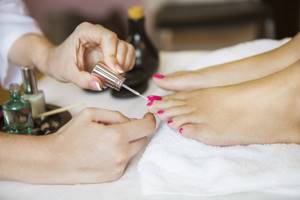
How can you infect your hands?
Have you been trying to cure FUNGUS for many years?
Head of the Institute: “You will be amazed at how easy it is to cure fungus by taking the product every day for 147 rubles ...
Read more "
Let's look at hand skin fungus and its main manifestations. Fungal manifestations on the skin, especially in open areas such as hands, are a very unpleasant phenomenon that brings its “owners” a lot of trouble in the form of itching, bleeding rashes, scabs, as well as inconvenience when communicating with people, the reason is clear. In general, fungal manifestations usually include infectious diseases that are caused by parasitic phages and fungi that are transmitted through tactile contact, usually “skin on skin.”
The average person may wonder whether there is a fungus on the palm of the hand? Happens! And this is very serious! The areas most often affected on the hands are between the fingers, palms and nails.
Types of fungus and signs of manifestation
- Damage to areas of the skin of the hands on the tips of the fingers and under the nails is a mychiosis fungus. At first, the disease appears to be a normal rash, sometimes called a "sweating rash." However, sweating of the hands is not the cause, but one of the main symptoms, which, together with the general antiseptic effect on the skin, leads to the appearance of brown and red-flesh colored scabs;
- mycosis - damage to the lower layers of the skin. A very difficult disease to treat, which is fraught with skin detachments and layers in the form of fungal infections.
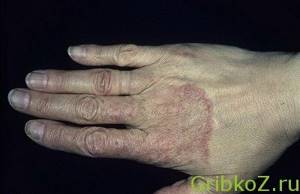
Common symptoms that accompany hand skin fungus include the following:
- interdigital rash, pimples filled with lymph, which form scabs when dry. Fungus on the palms of the hands can cause severe peeling at the folds of the capillary pattern of the palm, the so-called “life lines”, etc.;
- itching, which intensifies at night. Itching on the hands, which when scratched leads to the formation of scabs, deep scratches and bleeding irritations. Such symptoms, as a rule, are caused by a fungus on the hands between the fingers - Onychomycosis, which occurs in three stages, the final stage is tissue rotting;
- the appearance of swellings on the hands filled with lymph, similar in texture to calluses or burn blisters;
- flaky spots on the nails with transition to the skin and fingertips, finger folds;
- in general, the structure of the skin, the upper layers of the epidermis changes significantly, fungus on the skin of the legs and arms 90% out of 100 is accompanied by these symptoms;
- a strong fungus on the skin of the hands can lead to serious diseases of internal organs and systems, since mycosis and other similar manifestations can penetrate the body, disrupting the functioning of the thyroid gland and immunity.
Fungal metabolism and metaphysical properties
Fungi and spores differ significantly in their metabolism from plant organisms and animals. Skin fungus on the hands has unlimited growth potential, it all depends on the nutrient medium and time of manifestation. Hand fungus can grow, depleting the body, until the “mukor” - the body of the covering - is 100% occupied, for example, scabies spores.
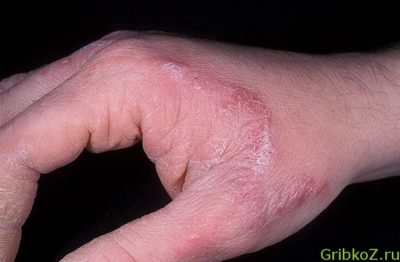
The fact is that the skin of human hands has a natural barrier to the penetration of parasites and phages - keratin plates, which are a rather dense layer of keratinized plates. When it comes into contact with the skin of the hands, the fungus grows through the keratinized “scales” and begins to distribute a specific substance in the lower layers of the skin - a substrate property that poisons the epidermal cells, binding them with toxins. The very first preventative measure against such manifestations is personal hygiene, which should be regular and mandatory. Skin fungus on the hands with a general weakening of the body can have very bad consequences:
- firstly, a violation of the skin structure can be irreversible, leading to the destruction of skin tissue and its rotting, damage to the joints and bone structure;
- secondly, why is fungus between the fingers so dangerous? Fungus between the fingers on the skin is dangerous due to a complication called Onychomycosis. Gradually, from small redness between the fingers, which in texture is similar to acne, a homogeneous area is formed, similar to redness from a burn, a slight swelling. at this stage, the disease is not so dangerous, but you need to keep in mind that inside the “swelling” there is a continuous reaction of division of fungal spores, the germination of which is carried out “in breadth and inward.” Eventually, the entire palm becomes covered with a brown scab; ultimately, such a fungus on the hands between the fingers can become an indication for amputation of the entire hand in order to prevent the disease from spreading to the entire body. It is also necessary to understand that a disease such as “leprosy” has similar roots to a fungus - first, skin damage begins, caused by weak immunity syndrome, then the damage spreads to the internal organs. The symptom of a weakened immune system and thyroid gland is a symptom characteristic of Onychomycosis.
Treatment and indications for treating fungus
First of all, any patient who has been diagnosed with a fungus on the hands needs to understand that treatment must be immediate and prompt. Otherwise, irreversible processes may occur that affect the entire body. The following antiseptic drugs and medicines for skin fungus on the hands have proven themselves to be excellent:
- "Mesoderil" in liquid form. The drug is available without a doctor's prescription and is a clear liquid that is applied locally to the skin. The substance contains an active antiseptic substance, which, when applied, causes a gentle interaction with the skin without the formation of an aggressive environment, gently penetrating into the lower layers, disinfecting the environment. When the medicine and fungal spores interact, the latter dissolve and the body heals;
- "Zodak" in the form of an ointment. It is also an antiseptic that acts on the upper layers of the skin without penetrating inside. Perfect for patients diagnosed with skin fungus on the hands and feet.
The patient must remember that skin fungus on the feet and hands is a “big headache”, and the best treatment for it is to exercise caution and personal hygiene.
Eczema
Is your toenail crumbling? Perhaps it's eczema. Yes, this chronic disease can manifest itself not only on the skin, but also on the nails. However, eczema first appears on the skin, then spreads to the nails.
At first, the hole on the nail plate becomes cloudy, begins to peel off, becomes loose and flakes. The nail itself becomes covered with transverse grooves, depressions appear, it crumbles and breaks. Swelling around the nail appears, blisters form, the skin cracks and peels. In advanced cases, the nail plate may completely separate from the nail bed.
This type of disease can be treated locally. Ointments containing vitamins are prescribed. You will have to follow a diet and carefully monitor hygiene. In this situation, nail extensions can help. The procedure will not only hide the problem, but also straighten the nail plate. Naturally, extensions can be carried out only after a course of treatment.
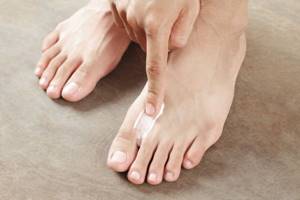
Ways to get rid of fingernail fungus
About 50 species of microorganisms that cause fungal diseases of the skin, nails and hair live with us on planet Earth. They are invisible, and the disease begins gradually.
A fifth of the population is infected with a mycotic infection that causes fingernail fungus, but not all of them show symptoms, and some do not notice them right away.
How does fingernail fungus start?
At the initial stage, it often looks like spots and abrasions, which can easily be confused with mechanical damage if you do not know the characteristics of the fungus.
Signs that you have nail fungus, or onychomycosis:
Pensioners! Don't cut fungal nails! They are derived simply: take 9 grams...
Military doctor: So that the soldiers do not have fungus, they 2 times a day...
- The color of the nail has changed;
- The nail has become thicker;
- The nail plate has delaminated and become fragile;
- Spots similar to mold have appeared;
- Burning, itching;
- Sweating or dry palms and fingers.
Damage to the nail can begin from its edges or from the base, it depends on the type of microorganism that has entered the tissue: candidal fungus or dermatophyte.
Fungus under the fingernail is caused by the genus Candida albicans. More often this happens in women due to the performance of wet household work, which contributes to the creation of conditions for the introduction of infection.
Infection begins with inflammation in the nail folds surrounding the nail. They swell, thicken, turn red and become covered with grayish scales. Touching them is painful.
Classification according to the course of the disease
- Normotrophic type - the structure of the plate does not change for a long time, but there are white and yellow spots. Gradually growing, they merge into one large spot, occupying almost the entire nail.
- Hypertrophic type of fungal disease of the hands - the skin near the nail bed becomes rough and thickened. The nail plate is compacted, with white and yellow spots in the depth. The nail becomes lumpy, with uneven edges, and the direction of its growth may change.
- Onycholytic type - the nail separates from the bed, the surface of the plate is white or white-yellow.
Classification by stages of development of mycosis
- Initial stage - small spots or stripes are visible in the center of the nail plate or at the edge.
- Middle stage - the spots increase, the plate becomes thicker, the outer layer of the plate peels off.
- Dystrophic stage - the skin surrounding the nail is inflamed, the nail crumbles. The pathogens that cause fingernail fungus spread to other parts of the body.
What contributes to infection
At risk are:
- Recently ill people, elderly patients with weakened immunity, diabetes, endocrine diseases.
- Persons who have taken broad-spectrum antibiotics for a long time, prescribed by a doctor or purchased prophylactically for self-medication.
- Patients receiving immunosuppressive medications - glucocorticoid hormones, cytostatics.
- Women who use false nails, under which favorable conditions are created for the growth of fungi.
- Specialists in professions associated with a humid environment: kitchen workers, employees in hotels, holiday homes, laundries.
- Workers of agricultural enterprises, confectionery factories and bakeries; persons who are keen on manicure - due to the effect on the nails of alkaline, chemical, degreasing solutions that help reduce the nail's resistance to fungal infections, and sugar-containing substances that create an environment for the life of pathogenic flora.
- Patients with damaged surface of the nail plate, regardless of the origin of the injury. Manicures, bruises, pinching, even splitting as a result of playing the guitar can increase the risk of onychomycosis.
- Patients who have been taking oral contraceptives for a long time.
- Neighbors and relatives of a person living with a fungus who lives with them. The risk of transmission of infection increases when sharing manicure items, bath accessories and bathing areas.
- Patients with mycoses of the feet or toenails.
Microorganisms that cause fingernail fungus are found in countless concentrations in public transport, baths, saunas, swimming pools, gyms and toilets.
But not everyone gets sick, because... many are helped by hereditary resistance to microorganisms, their own healthy immunity and adherence to hygiene rules.
Dangerous consequences of fungus on the hands
If you do not pay attention to the aesthetic inconveniences of nail fungus and delay visiting a doctor, or hope that the body will cope on its own, after a while a problem will arise associated with complications.
Often, fingernail fungus develops slowly and does not cause concern, but at any time when the body’s defenses are weakened due to another disease, season or age, mycotic microorganisms can become active and cause harm to health:
- Transfer of the process to the skin of the hands;
- Inflammation due to bacterial infection of damaged tissues;
- Erysipelas of the hand;
- Invasions of mycotic origin;
- Infection of the nail with mold fungi;
- Allergic manifestations due to intoxication of the body with waste products of fungi.
A person who neglects treatment for fungal nail disease spreads the infection to other people.
Treatment of nail fungus with medications
When visiting a dermatologist, there will be no diagnostic difficulties, but to clarify the type of infectious agent, the doctor will prescribe several tests:
- Scraping the surface of the nail plate;
- Analysis of skin flakes of the periungual fold;
- Culture for reaction to antifungal drugs.
This information will help to prescribe the right treatment as quickly as possible and ensure the patient’s recovery.
If the treatment regimen specified by the dermatologist is not followed, the infection may become resistant to the drugs, and the course of therapy will have to be repeated in a more intensive form.
Treatment is carried out according to the scheme, together with drugs for local (external) and internal use. For external use, the doctor may prescribe solutions, creams or ointments:
- Triderm;
- Mikozan;
- Clotrimazole;
- Lamisil;
- Exoderil;
- Terbinafine;
- Nystatin, levorin ointments.
In combination with these drugs for oral administration, strictly under the supervision of a doctor (since there are contraindications), tablets or capsules for nail fungus can be prescribed:
- Mikosist;
- Diflucan;
- Nystatin;
- Fluconazole.
At the initial stage, if the degree of development of the disease is small, the fungus affects up to 50% of the nail area; medicinal varnishes and sprays may be prescribed by the doctor.
In mild cases, the result can be seen within two days after applying medicinal cosmetics.
How to use varnishes and sprays:
- Batrafen (varnish) – treatment of the nail every 2 days for 1 month. For the next month, treat the nail 2 times a week. From the third month onwards - once a month.
- Terbix + Terbinafine (spray) – 2 times a day, the spray is sprayed onto the nail and adjacent skin after first wiping the nail with alcohol.
- Demicten (varnish) – daily use, destroys microorganisms on the surface of the nail and skin, reduces unpleasant odor from hands.
- Candide (lotion) – up to 3 times daily, rubbed into the nail plate.
If the disease has reached an advanced stage and more than 70% of the nail area is affected by the fungus, treatment will take time. Your doctor will tell you how to cure fingernail fungus quickly in this situation. He will take into account all contraindications and individual characteristics of the course of the disease.
It is performed only in a dermatologist’s office using a special instrument after disinfection and softening of the nail plate.
During this procedure, the top layer of the nail plate is cleaned off, making it easier for medications to reach the tissues. Medicinal substances begin their work faster and penetrate deeper. Laser exposure, as a treatment method, destroys fungal spores over several procedures, if the course of the disease is not complicated.
In case of severe complications, drug therapy is also supplemented with laser treatment. Surgical removal is used in especially rare cases when other methods of treating onychomycosis do not help. The procedure is painful and has contraindications.
Treatment of nail fungus with folk remedies
The most effective treatment method in your case can only be selected based on collecting information about the type of microorganism and the severity of mycosis.
But if there are contraindications to taking medications internally, it will be acceptable for you to use home procedures.
Natural remedies used to treat nail fungus include:
- Hydrogen peroxide;
- Mint;
- Propolis;
- Tea mushroom;
- Celandine;
- Kalanchoe;
- Iodine;
- Acetic acid;
- Apple vinegar.
How to use:
- Tea tree oil. Apply it to your nails after steaming.
- Garlic. Apply a grated mass of 2-3 cloves of garlic mixed with butter to the nail plate every day.
- Apple vinegar. Dip your fingers into vinegar diluted in a 1:2 ratio twice a day and hold for 10 minutes.
- Acetic essence, glycerin and alcohol. Mix a small amount in a 2:1:2 ratio. Apply as a compress.
- Tea or coffee. Brew tightly, dip your fingers into the vessel with the brew. Has an antifungal effect.
Prevention of fingernail fungus
Given the prevalence of the infection and the ease of infection, the ability of a mycotic infection to be transmitted from person to person, following the rules of hygiene will help protect yourself from nail fungus:
- Do not use other people’s manicure devices and do not give your own to anyone;
- If you are getting a manicure in a beauty salon, make sure that the technician has sterile instruments;
- Avoid injury to your nails, do not wear extended nails for a long time;
- In the house where a person with mycosis lives, thoroughly disinfect surfaces accessible to contact and use only personal hygiene items, towels, nail files, washcloths and gloves;
- After returning from the street, wash your hands;
- Wash your hands after contact with animals;
- Use hand cream with antifungal effect;
- Disinfect household manicure supplies;
- Treat any wound with an antiseptic;
- Boost your immunity by hardening yourself and taking vitamins.
And most importantly, at the first suspicion of a fungal infection, do not wait for events to develop, but visit a dermatologist or mycologist, who will tell you how to quickly deal with the problem.
Other pathological problems
In addition to the reasons described above, a toenail may crumble in other cases:
- Climax. During this period of life, when hormonal changes occur in the female body, there is a serious lack of estrogen. And this is a violation of mineral metabolism, almost all organs suffer.
- Liver diseases. In such cases, the metabolism in the body is disrupted, which is why the nails suffer.
- Lichen. This is a viral disease that requires medical intervention.
- Intoxication of the whole body.
But still, the most common reason for a toenail crumbling is fungal diseases. Onychomycosis can be contracted in the most unexpected places: on the beach or in the pool. Doctors are also confident that people with a genetic predisposition are more often susceptible to this disease, that is, if the fungus is present in blood relatives, then the child has a huge risk of also getting onychomycosis.
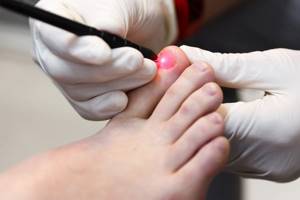
Peeling nails: causes and remedies for nail destruction
Russia+7
Peeling nails is a very common problem that can lead to the nails breaking down and then completely peeling off.
Let's look in detail at what can be done to prevent the deterioration of nails and restore good health with herbal medicine or home remedies.
Peeling nails - features
Weak nails can appear in different ways and with different symptoms .
First, we can divide peeling nails into two broad categories:
- Idiopathic , i.e. due to physiological aging and the influence of environmental factors.
- Traumatic , i.e. caused by injuries and microtraumas of the nail plate.
Secondly, nails can peel off horizontally or vertically . Peeling nails can also be associated with symptoms such as:
- Yellow stains, often caused by cigarette smoking, improper use of nail polish, or the use of harsh cleaning products.
- White spots are present almost exclusively in cases of fungal nail infection or nail psoriasis.
- Jaggedness of the nail, i.e. the edge of the nail plate becomes wavy and jagged.
Causes of peeling nails
The causes of peeling nails can be endogenous , i.e., depend on factors such as internal diseases, physiological conditions or lack of nutrition, or exogenous , i.e., depend on environmental factors and external influences.
Endogenous causes of nail peeling
All endogenous causes of peeling nails include all those problems that act “from within ,” i.e. reasons related to diseases or conditions of our body.
Among those that most often lead to nail destruction we have:
- Amino acid deficiency: Nails are made of a protein - keratin - formed mainly from amino acids such as glutamic acid, cysteine and arginine. A deficiency of these amino acids, associated, for example, with poor diet or age, can lead to peeling nails.
- Vitamin and Mineral Deficiency: Deficiency of vitamins B6, C, E, D and K and minerals such as copper, iron, calcium and zinc can lead to peeling nails as keratin also contains these trace minerals.
- Onychomycosis: The nail may also peel due to a fungal infection. The fungi that most often lead to this problem are Trichophyton mentagrophytes Trichophyton rubrum.
- Thyroid pathologies: diseases such as hyperthyroidism lead to changes in metabolism in the body. In particular, they affect calcium metabolism, and this causes problems even at the nail level.
- Anemia: Peeling nails can be a result of iron deficiency anemia, i.e. the type of anemia that occurs due to iron deficiency.
- Celiac disease: Gluten intolerance causes various problems, one of them is the malabsorption of nutrients, including amino acids, vitamins and mineral salts, substances necessary for the proper formation of the nail plate.
- Psoriasis: This autoimmune skin disease can also affect the nails, making them weak and prone to decay. Whitish spots also appear on the nails.
- Stress: Severe stress can cause peeling nails. In fact, stress determines various metabolic disorders, including vitamin and mineral deficiencies.
- Menopause: The menopause period may be responsible for nail peeling. Due to the lack of estrogen, calcium metabolism is disrupted, which causes problems with bones and nails.
Exogenous causes of nail peeling
All exogenous causes of nail peeling relate to those factors that act “from the outside” and which determine the fragility of the nails.
Among them we have:
- Cold: With the arrival of winter or when staying in very cold places, the body tends to become dehydrated and lack of water is one of the main reasons for peeling nails.
- Nail polish: Using inappropriate polishes, low quality polishes or too aggressive solvents is one of the reasons for weakened nails.
- Detergents: Those who use detergents with a pH that is too high (above 7) or too low (below 3) for home cleaning and do not use appropriate protective gloves may experience nail damage.
- Nail biting: The habit of holding nails in the mouth, licking them or biting them creates microtraumas on the nail plate and causes peeling.
- Reconstruction and cosmetic procedures: Nail extensions made with gel, or the application of UV-sensitive varnish, are responsible for injuries and microtraumas of the nails.
Phytotherapy
Herbal medicine for treating nails is based on the restorative effect of the active ingredients of various plants.
Among them we have:
Essential Oils: These oils, obtained from various plants, have emollient and regenerative properties and are therefore useful for repairing flaky nails. The essential oil of wheat germ, lemon and sweet almond is very useful; it is applied directly to the damaged part using a cotton pad.
Horsetail: Contains silicon dioxide, flavone glycosides and minerals such as calcium, magnesium and potassium.
Thanks to its active ingredients, horsetail has a remineralizing effect and is therefore indicated in all those cases in which peeling nails are due to a lack of minerals.
Used as an infusion (a tablespoon of horsetail is brought to a boil in a glass of water, boiled for about 3-4 minutes, left to infuse for ten minutes, strained and drunk), tincture (about 30 drops three times a day) or dry extract (in capsules).
Tea Tree Oil: Contains many active ingredients, the most important of which are terpinol and cineole. It is especially useful in case of peeling nails due to a fungal infection.
Castor Oil: Contains active ingredients such as fatty acids (particularly ricinoleic acid) that help strengthen nails and reduce flaking. Apply directly to the nail after heating for a few minutes, massaging and leaving for at least an hour.
Home Remedies
Home or "granny" remedies offer the use of substances available in most homes.
To help a flaky nail recover, you can use:
- Olive oil: has emollient and regenerating properties and can therefore help restore healthy nails. Apply directly to nails, massaging lightly, or you can apply compresses.
- Water and Lemon: This remedy is useful for both strengthening nails and combating yellowing. It is recommended to immerse your hands in a mixture of water and lemon and hold there for several minutes.
- Firming mask: mix two tablespoons of yogurt, two teaspoons of honey, a couple of tablespoons of avocado pulp and a small amount of shea butter. Mix everything until you get a creamy consistency, apply to each nail and leave for a quarter of an hour, then rinse.
What to do to prevent your nails from peeling off
Below are some tips that may be helpful in preventing peeling nails:
- In case of nutritional deficiencies or periods of intense stress, you can take multivitamin supplements and mineral salts to enhance the keratin saturation of your nails.
- If you plan to use harsh detergents and cleaners, always wear protective gloves.
- If you want to have a flawless manicure and maintain healthy nails, turn to professionals who use quality products and who know how to avoid nail damage.
- In the case of a fungal nail infection, you can buy remedies at the pharmacy to treat the problem. However, it is recommended to consult a physician and perform a dermatological examination before using any medical product.
- Eat a diet that contains foods rich in vitamins and minerals.
- Drink at least 1.5-2 liters of water per day to avoid dehydration.
- Avoid cigarette smoke, which increases free radicals and oxidative stress.
- If you do your manicure at home, try not to use solvents with acetone, do not cut your nails with scissors (use nail clippers), use a file that is not too hard, and use a good quality polish.
- Avoid, as much as possible, biting your nails and putting your fingers in your mouth.
Source: //sekretizdorovya.ru/blog/prichiny_rasslaivanija_nogtej/2017-02-22-322
How to treat?
If the nail on your big toe is crumbling, but it is clearly known that this is not due to any disease, then, first of all, you should start with adjusting your diet. The menu should include the maximum amount of fruits (apricots, citrus fruits), fermented milk products, spinach and nuts.
To achieve the maximum required level of iron, selenium and iodine in the body, it is not necessary to take pills. There is a lot of it in apples, seafood, beef liver, seaweed, and brewer's yeast.
Wax can help correct the situation. For the procedure, you need to melt 5 or 6 tablespoons of wax in a steam bath, after cooling, immerse your hands or feet there (10-15 minutes), doing this 2-3 times for 7 days. It is better to carry out the procedure before going to bed and, without cleaning the nails from wax, go to bed.
You can take baths with sea salt every day. It is recommended to treat the damaged finger daily with sea buckthorn or olive oil.
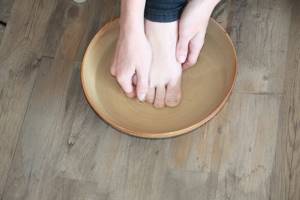
Skin treatment
If the skin around the nails is very dry, and preventive measures no longer have the desired effect, there is no need to go to an expensive salon. The situation can be corrected independently with the help of peeling, baths, masks and creams.
- Nourishing masks
For the mask you will need aloe juice (prevents infections), honey and olive oil. All ingredients must be thoroughly mixed to obtain a homogeneous mass, applied to the cuticles and left for several minutes. The procedure can be repeated twice a week in the evenings.
- Peeling
To exfoliate dead skin cells, it is recommended to use special scrubs with natural ingredients. You can also make an effective cosmetic product at home. To do this, mix olive oil, water and sugar in equal proportions. The resulting consistency is used to massage the cuticle in a circular motion, after which the mixture is washed off. When doing a manicure, be sure to use ceramic nail files. After the bath, they gently remove dead skin without damaging the skin. The file functions as a scrub.
- Creams
To treat dry skin directly under the nails, it is necessary to use creams that include shea butter, almond or coconut oil, glycerin, vitamins E and C. It is noteworthy that any ordinary cream can be turned into a healing one if you add lemon and rose essential oils to it and grapefruit (5 drops of oil per 20 ml of cream). It is very good if the cream has UV protection. This way it will provide cuticle protection and reduce the negative effects of the sun - one of the factors of skin aging.
- Cuticle massage
Lack of vitamin E is the main reason why skin becomes dry. Its deficiency can also be replenished through external use. Vitamin E can be found in the form of oil in any pharmacy. Rub the product into your fingertips with gentle massaging movements. You can treat each nail in the same way. The procedure must be repeated three times a week.
- Hand baths
Raw potatoes are an excellent remedy for dry skin because they contain vitamin E. Crush them and mix them with a glass of hot water, then add a couple of glasses of milk. Place your hands in the resulting solution for 20 minutes. This bath will help moisturize the cuticle and soften the skin ridges. Starch is also used in skin treatment. For 15 minutes, place your fingers in hot water with the addition of a tablespoon of starch. The procedure is recommended to be carried out in the evening before bedtime. After use, hands are wiped dry. Moisturizing cream will help consolidate the results.
Surely many have noticed that after a vacation at sea, nails become stronger, and the skin of the hands becomes much softer and more pleasant to the touch. It's all about sea water, which contains iodine. You can achieve the same result at home by taking an aromatic bath. You need to dissolve a couple of tablespoons of sea salt in water, then add a few drops of any essential oil (lemon, rose, grape seed, etc.) and soak your hands in the water for 10-15 minutes. The result is visible after the first procedure.
Dry skin around fingernails is the most common complaint people have. Why does the cuticle area dry out? For many, the main reason is the influence of weather conditions. , and especially fingers, are most often exposed to adverse factors from the external environment.
Internal dysfunction is often the culprit. A dermatologist will help you understand the causes of all problems with the epidermis. He will also prescribe treatment and cosmetics designed to care for dry areas around the nails.
Salon treatments
What to do - your toenails are crumbling. Sign up for procedures. However, before going to a beauty salon, it is still recommended to undergo an examination to exclude any pathology.
One of the most popular procedures is paraffin therapy. It is somewhat reminiscent of a wax procedure that can be done at home. The salon may offer you a massage course; by the way, many effective techniques have been invented for nails.
Some salons offer a course of diathermy, that is, exposure to nails in order to improve vascular nutrition and blood circulation. Similar to the hospital procedure - ultraphoresis, salon procedures are also carried out, only with the name vitamin ultraphoresis. When treating nails, their surface is saturated with vitamin compounds.
The sealing procedure involves applying a nutrient solution to the nail and securing it with wax. The effectiveness of the procedure can be observed for three months, then you will have to repeat everything again. What else can you do if your toenail crumbles?
Spa pedicure is not a one-day procedure, but a whole complex that involves not only a visit to the salon, but also care at home.
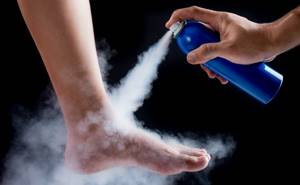
Causes of cracked skin around fingernails
The main mechanism for the appearance of dryness near the nail plates is dehydration of the epidermis. The consequence of this process is cracks and bleeding. The main reasons leading to moisture deficiency in cells are as follows:
If the hardening is not associated with infection, then in the initial stages you can treat yourself using homemade remedies.
Methods of combating dehydration should be comprehensive if the cause of dry epidermis is associated with internal factors.
When exposed to external conditions, emphasis should be placed on proper care with the selection of suitable products, taking into account the specific skin type. Treatment includes:
- nutrition correction;
- , wraps and baths;
- use of ointments.
If your intake of vitamins from food is insufficient, you need to change your diet. The skin does not receive the substances it needs to maintain a healthy appearance, which is why it peels off in the future.
During the day, carrots, tomatoes, pumpkin or greens must be present in the diet. They are sources of vitamin A. Eggs, cheese, potatoes and corn are good sources of many nutrients. They are considered the most valuable due to the presence of vitamin E in their composition.
In addition to a diet enriched with vitamins, it is important to have sufficient water in the body (2-2.5 liters per day).
If you get tired of drinking tasteless liquid, then add ginger, lemon juice, honey or mint for variety.
Getting rid of the problem at home
In the evening, every day you need to moisturize the epidermis of your fingers in a bath with natural products. Dry cuticles are softened by adding vitamin E, lemon juice, milk or various oils. It is recommended to take baths in the evening for 15-20 minutes.
Remaining oils are removed with a napkin and the procedure is completed by applying a nourishing cream taking into account your skin type. Particular attention is paid to the areas around the nails.
To prepare the mask, use milk, boiled potatoes, rye bread, eggs, various oils and honey. The components are mixed in equal proportions until a thick consistency is obtained. If desired, no ingredient is added.
The mask is applied in a thick layer to the hands and fingers. Particular attention is paid to flaky areas. The duration of the procedure is no more than 20 minutes, and it is recommended to repeat it daily.
Use of pharmaceuticals
Additionally, for advanced forms, Radevit ointment is used. It is rich in nutritional components such as:
- vitamin A;
- glycerol;
- fatty acid;
- sunflower oil;
- Vaseline oil.
If the areas crack and treatment does not help, then Actovegin injections are used as a wound-healing drug. Sometimes you can pamper yourself with salon treatments (paraffin baths, hot oil manicure).
Professional cosmetics combine all the components necessary for the epidermis. After applying the product to problem areas, the skin becomes soft and velvety.
In most cases, the skin around the fingernails peels and dries due to vitamin deficiency and improper care. Nourishing cosmetics are best prepared at home. The main thing is to stock up on oils and combine them with ingredients that are beneficial for the skin.
Prevention
If your toenails are crumbling, treatment is, of course, required, but it is best to prevent this condition. First of all, you should control sweating on your feet and hands. Be sure to wash your feet daily, even if they seem clean.
After visiting public places, especially those with high humidity (swimming pool, sauna, beach), it is better to treat the limbs with a special antifungal aerosol.
Women should not skimp on cosmetics, including nail polishes. Don't forget to apply a protectant before applying varnish. If you prefer salon procedures, then carefully choose a specialist so that he is responsible for the sanitary treatment of instruments.
And, of course, eat a balanced diet, avoid spontaneous snacks and fast foods, as such nutrition causes vitamin deficiency in the body.
Causes
The cuticle is the skin at the base of the nail that prevents bacteria from getting underneath it. The skin folds are located on the sides of the nail plate. Their cover consists of keratinized cells, which, as they die, dry out and become rough, forming hangnails. Trying to tear them off or accidentally catching them, you can get wounds that trigger an inflammatory process in the body. Pus accumulates near the nail plate, causing pain and discomfort.
Let's look at the main causes of dry skin around the nails.
- Exposure to aggressive household chemicals. Housewives who do daily cleaning often neglect to wear gloves when using cleaning products. Chemical compounds quickly make the skin dry and can also provoke allergic reactions.
- Incorrect treatment of the cuticle during manicure. Cutting off the protective layer of keratinized skin leads to increased tissue regeneration, so the skin begins to grow more intensively.
- Poor nutrition. Dry skin around the fingernails can signal a deficiency of essential substances in the body. Sometimes it is enough to supplement your diet with foods containing vitamins A and E. In some cases, it is worth contacting your doctor or dermatologist to prescribe treatment.
- Lack of water in the body. It is recommended to drink 3-4 liters of water daily to solve the problem of dry cuticles.
- Temperature changes. In winter, the problem of dry skin occurs most often, since cold air negatively affects the general condition of the skin. The same thing happens in the hot summer.
- Tight shoes. Uncomfortable shoes can not only lead to cracks, but also cause the nail to cut into the skin.
- Low-quality perfumes or cosmetics. Before purchasing, you should carefully study the composition of nail products, giving preference only to products with natural ingredients.
Diseases of the body
Peeling of the skin around the nails is not always so harmless. Sometimes this may indicate the presence of a chronic disease in the body. Such as diabetes mellitus, for example. In addition, the following diseases may manifest themselves in a similar way:
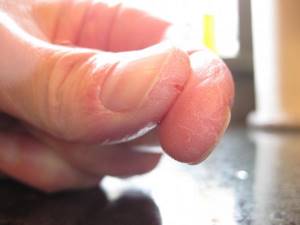
Cracks around nails
- Hormonal imbalances;
- Metabolic disease;
- Diseases of the digestive system and gastrointestinal tract;
- Eczema (may appear like this in the early stages);
- Thyroid diseases.
If the cause of the cracks is one of these diseases, then you should not self-medicate. In addition to peeling, skin cracks may also occur. They can bleed, hurt, and cause significant discomfort. If they do not go away long enough, it is better to contact a specialist.
Home Remedies and Methods
In most cases, dry skin around the nails is more of a cosmetic problem than a health problem. However, before you accept dry skin as a harmless condition, you will need to get checked by a dermatologist to find out the cause.
If not properly treated or left untreated, dry skin around the nail can lead to other symptoms such as severe itching, cracking and flaking of the skin around the affected area. When dryness is not caused by a life-threatening condition, then you can control and manage the condition at home with simple natural and folk remedies.
Soak your hands in warm water
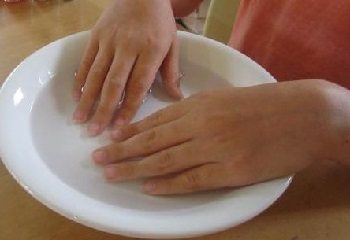
To relieve pain, irritation, and itching, you can apply a warm compress or soak your hands in a bowl of warm water. It will help soften the skin around the nails, relieving these symptoms.
After this, dry your hands with a clean towel. Make sure your cuticles are dry but remain soft while you do your manicure.
Another powerful natural remedy that you can use on dry skin is natural honey. Raw organic honey is rich in anti-inflammatory properties and relieves itching. After washing and drying your hands, apply a few drops of honey and leave it on for 20 minutes before rinsing.
You can also make a mixture of honey and olive oil and the results will be twice as good. For this:
- Add equal amounts of honey and olive oil to a bowl
- Stir slowly
- Apply the mixture to the affected area around the nail
- Leave it on for 20 minutes before rinsing with warm water and mild soap
- Repeat this twice a day
Aloe vera gel
Aloe vera has natural antiseptic and antibacterial properties. In addition to fighting infection on chapped skin, aloe vera is an excellent cooling and soothing agent. You can either apply it to the affected area or drink it.
As a way to prevent and fight infection, drink two tablespoons of aloe vera gel diluted in water daily. For taste, you can add an equal amount of honey.
Wet your hand in diluted bleach
For dry skin around the nail caused by a fungal infection, you can fight the infection and relieve symptoms by soaking your hands in diluted household bleach (bleach).
To prepare the product:
- Dilute a small amount of bleach with an equal amount of water
- Soak your hands in the mixture for about 20 minutes
- Repeat this process two or three times a day
- If dryness persists, contact your doctor as soon as possible.
Moisturizers
Moisturizers or emollients are complex chemical mixtures designed to make the outer layer of skin softer and more pliable. Skin moisturizers increase skin hydration by reducing evaporation. These creams are available over-the-counter and by prescription.
Multivitamins and nutritional supplements
When the underlying cause is a vitamin deficiency, multivitamins and nutritional supplements can help resolve it quickly. To prevent overdose or underdose, it is important that they are prescribed by a specialist.
Strict nail and cuticle care regimen
When your skin is constantly exposed to drying substances, neglecting to do so can make the condition worse. Changing your skin care routine can help improve the condition and prevent cracking or flaking of the skin. A good manicure and cuticle removal are important to eliminate dry skin around the nail and prevent it from recurring in the future.
Dry nails bother many people, especially in winter and spring. Dry nail plate is often accompanied by problems with the cuticle and skin around the fingers. Sometimes this phenomenon is observed on the legs. Adults and children are susceptible to dry nails. What should you do if your child develops cracks in the skin around the nails and painful hangnails due to dryness? It is necessary to find out the causes and ways to solve this problem.
Baths
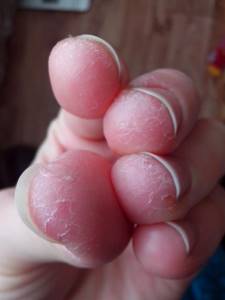
The best bath against flaking skin is a starch bath. To prepare it, one tablespoon of edible potato starch is diluted in one liter of hot water. This bath is carried out for a quarter of an hour. After finishing, you need to thoroughly dry your hands with a towel and lubricate them with nourishing cream.
In addition, a potato bath promotes effective healing. Combine two glasses of water with a glass of milk and add crushed boiled potatoes to the mixture. Mix everything thoroughly and place it in your hands for twenty minutes. After this time, wipe your hands with a towel and lubricate with rich cream.
Shilajit also helps with flaking, especially if it is accompanied by itching. It is necessary to dilute the tablets of the product in water, and then dip your hands in this solution. After this, do not wipe the brushes. The product not only moisturizes well, but also relieves itching and irritation.
Preventive measures
Preventing dry skin near the nails is much easier than having to deal with long-term treatment later. To ensure that your hands always look well-groomed, you should follow simple rules.
- Cleaning should only be done with gloves. Choose dishwashing detergents with glycerin, which moisturizes the skin and neutralizes the negative effects of bleach.
- Wash your hands with liquid moisturizing cream soap. To improve blood supply and train blood vessels, start the procedure with warm water and end with cold water. Dry your hands thoroughly with a towel.
- During the cold season, wear mittens or gloves and keep your hands warm.
- Watch your diet: add to your diet foods containing vitamins A (tomatoes, carrots, apricots, pumpkin, peas) and E (corn, eggs, cheese, potatoes).
- Do it. Its essence lies in the fact that the dry cuticle is not cut off, but is softened and gently pushed aside. Before the procedure, be sure to take a bath with special cuticle oil. Treat your toenails in the same way.
- Avoid rough scrubs and massage your fingers with olive oil from time to time.
- Try to avoid stressful situations, overwork and overexertion - all this negatively affects both your general well-being and the condition of the skin of your hands.
